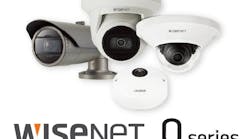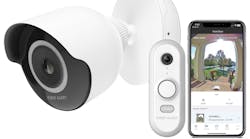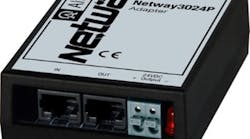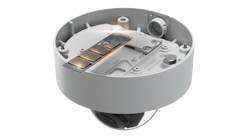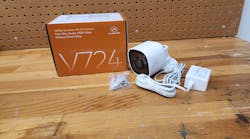Shipped in a single box with the camera and lens already mounted in the enclosure, “plug-and-play” packages from a single manufacturer simplify installation as well as the ordering process.
Although once expensive and considered only for high-end applications, video surveillance equipment costs and the perceived value that video surveillance offers to the end-user have made video systems feasible for a wide range of applications.
As is the case with most aspects of the modern world, technology is constantly advancing so it is to the locksmith's advantage to stay up to date with new products and techniques.
Earlier on in the evolution of CCTV, cameras typically were supplied as individual components -- the camera body, the lens and the housing -- and configured by the installer for each installation.
Although this is still a common practice, especially for special applications, some manufacturers offer camera “packages” designed for use in specific applications - both indoors and out. These packaged camera systems include not only a camera and its appropriate lens, but also the housing, mounting device, and all applicable hardware. These packages can be simple board cameras with integral lens, or advanced high resolution cameras with speed dome bases and environmental housings. The concept is the same. Shipped in a single box with the camera and lens already mounted in the enclosure, these “plug-and-play” packages simplify installation as well as the ordering process. This approach represents a savings in time ordering, in assembly of the camera on the job-site, and the cost is typically equal to or less than the sum of the individual components.
The concept of bundled or kitted component systems is not something new to the security industry and now it has been adapted by the video industry. The benefit to the manufacturer is that the components in the system will be all one brand, their brand. And the inducement is strong for the installer. We recently ordered one such package for a project, knowing we would probably swap out the mounting bracket since it was a custom installation.
The additional benefit to the installers is that he can be sure that all the components he orders will work with each other; the lens will fit the camera, the camera and lens will fit in the enclosure, and the mounting bracket will support the housing.
Color cameras have become the defacto standard for most video surveillance systems. Because of the economics of mass production, the price difference between black and white and color is negligible, and the performance characteristics of color cameras is almost equal to that of monochrome. Color offers improved resolution, sharper images, and a more true-to-life video presentation than that of a black and white camera. Their only drawback is that they require a higher level of illumination to create a visual image than does a black and white camera.
To provide the maximum night-time performance for critical applications, one solution is the day/night camera, which includes a color camera and a black and white camera in the same housing. The camera senses when the light level is sufficiently low that it will impair image quality, and automatically connects the black and white camera.
Another night vision design incorporates IR LED (Infrared Light Emitting Diode) arrays to light the scene, and thereby permitting the camera so see in the dark. This type of lighting and surveillance is used when the area under surveillance or those be watched do not know the camera is observing them. Otherwise conventional outdoor lighting can also be added to the system to provide the safety and convenience that being able to see with the naked eye provides.
Another significant improvement in camera technology is the introduction of variable-speed camera positioning devices that provide both video signal transmission and remote control camera movement (pan-tilt) using a single coaxial cable, simplifying installation and reducing cost. Previously, a coaxial cable transmitted the video signal, and a separate set of conductors provided remote control of the camera's horizontal (pan) and vertical (tilt) movement.
Advancements in camera technology have also prompted the development of higher quality monitors both for live viewing and playback of recorded images. Large flat panel LCD screens are replacing the venerable CRT type display.
These screens are comprised of a single sheet of glass that uses primary colors to produce an extremely sharp display without the appearance of faint duplicate or secondary images (ghosts) associated with previous generation LCD screens.
The digital video recorder (DVR) has largely replaced the VCR in video surveillance applications and brings all the advantages of digital signal processing to the process of recording, storing, transmitting and reviewing of video images.
Recording digitally is done either with a dedicated box or with PCs equipped with video capture cards. Which type you use will depend on the particular application, and your level of expertise.
Replacement of the VCR as a key component in a video surveillance system not only eliminates the purchase, changing, cataloging, and storage problems associated with VHS tapes, but also provides a major upgrade in the overall quality of video recording.
A DVR is a computer that digitally records and stores the visual images transmitted from the video surveillance cameras linked to it. The DVR shares the same data compression technology as a computer, enhancing the amount of information it can save for future use.
The amount of actual storage space depends on the size of the unit's disk drive, which may range from 80 GB (1 gigabyte is equal to 1024 megabytes) to 1 TB (1 terabyte is equal to 1024 gigabytes).
“Unlimited” storage is achievable through the use of redundant arrays of independent disks (RAID) server. With this option, recorded images can be partitioned over several different disk storage drives. Similarly multiple DVRs can be linked over a network, to support, view and record an unlimited number of cameras at an unlimited number of locations.
The advantages of using a DVR instead of the traditional VCR are numerous. Unlike VHS tapes, which lose picture quality when reused and recorded over on several occasions, digital images recorded by the DVR never degrade. Instead, they maintain a crisp, sharp presentation, regardless of the number of times they're played or reviewed.
Additionally, problems associated with videotape stretching, tearing, or breaking due to repeated use are avoided. Digital images recorded by a DVR are stored by both date and time and can be easily recalled for playback, while the search for a specific recorded event associated with a VCR is very time consuming. Both the PC-based and embedded operating system styles of digital video recorders provide functions usually related to computer networks, including remote recording, viewing, and playback without compromising image quality during the transfer and receipt of video images.
Another feature associated with DVRs is their ability to record at higher frame rates than those associated with a VCR, providing enhanced visual quality and image definition. At 30 frames per second, the DVR captures events in the same manner as the human eye sees and processes information, which led to the term “real-time” video.
Multiple channel DVRs offer functions previously associated with separate system components, such as a matrix switcher or a multiplexer.
DVRs and video servers typically provide the ability to record multiple cameras individually, as well as simultaneously view prerecorded video from selected cameras over multiple monitors from multiple locations.
Although the term digital is used liberally in video, there are several aspects to a video system which may not fill the strict definition. Although virtually all cameras use digital imaging, not all cameras transmit the image to the system digitally. The legacy transmission system is coaxial cable which is considered analog. Other cameras use UTP (unshielded twisted pair) wire to transmit the image. IP cameras are network devices which transmit images digitally to the head-end of the respective system.
It could be argued that any system using a hard-wired connection, such as coaxial cable, unshielded twisted pair topper conductor, or fiber-optic cabling to connect cameras to head-end equipment, is an analog system. Therefore, because the majority of video surveillance systems currently in use rely on a hard-wired connection for the transmission of video signals, they are still considered analog, regardless of individual components that use some form of digital technology.
A digital system uses network based Internet Protocol (IP) components for the transmission of all-digital, 8-bit ( or higher) video signals at a wavelength of 1,310 nanometers from digital IP cameras with built-in Ethernet interface over a network to a digital video recorder or network video recorder.(NVR).
What's next? Multi-pixel cameras are already here, and growing in use. They enable larger fields of view without sacrificing image quality; that is to say, they are capable of achieving what is considered acceptable image qualities. Processors allow the system user to crop and zoom to a specific region of the total camera view. This technique along with on camera recording capabilities and image motion detectors which stretch image storage capacities and conserve network bandwidth, are generally regarded as the trends of the future in video surveillance.
